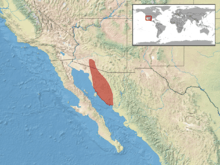Chionactis palarostris
| Chionactis palarostris | |
|---|---|
| Scientific classification | |
| Kingdom: | Animalia |
| Phylum: | Chordata |
| Subphylum: | Vertebrata |
| Class: | Reptilia |
| Order: | Squamata |
| Suborder: | Serpentes |
| Family: | Colubridae |
| Subfamily: | Colubrinae |
| Genus: | Chionactis |
| Species: | C. palarostris |
| Binomial name | |
| Chionactis palarostris (Klauber, 1937) | |
 | |
| Synonyms | |
| |
Chionactis palarostris, commonly known as the Sonoran shovelnose snake, is a species of small nonvenomous colubrid which is a native of the Sonoran Desert in North America. It is one of only two species in the genus Chionactis.[2]
Etymology
The specific name, palarostris, is from Latin: pāla (shovel) and rōstrum (beak or snout).
Geographic range
C. palarostris is found in the southwestern United States and northwestern Mexico. In the United States it is found only in Organ Pipe Cactus National Monument of western Pima County, Arizona. The subspecies occurring there is called the Organ Pipe shovelnose snake (C. p. organica). In Mexico it is found only in the state of Sonora.[3]
Description
C. palarostris is cross-banded with black, yellow (or whitish), and red bands. Consequently, it resembles the Sonoran coral snake (Micruroides euryxanthus). The mnemonic "red on yellow kill a fellow, red on black, friend of Jack" doesn't work with this snake. However, unlike the coral snake, which has a black snout, Chionactis palarostris has a yellow snout and is not venomous. Also on a coral snake, the bands go all the way around, but C. palarostris has a solid yellow belly.[4]
The smooth dorsal scales are arranged in 15 rows at midbody; ventrals, 141-181; subcaudals, 34-64, divided.[4]
Maximum total length (including tail) of adults is 43 cm (17 in).
Subspecies
Two subspecies are recognized, including the nominotypical subspecies.
- Chionactis palarostris organica Klauber, 1951 - Organ Pipe shovelnose snake
- Chionactis palarostris palarostris (Klauber, 1937) - Sonoran shovelnose snake[5]
Behavior
C. palarostris is active in the evening and at night, mostly near washes.
Diet
Snakes of the genus Chionactis prey upon insects and other arthropods such as centipedes, scorpions, and spiders. They also eat the pupae of ants, butterflies and moths, and other insects; and they have been known to eat the eggs of small species of lizards.[6]
Reproduction
Sexually mature Chionactis mate in spring, and the female lays a clutch of up to five eggs in summer.
References
- ↑ The Reptile Database. www.reptile-database.org.
- ↑ ITIS (Integrated Taxonomic Information System). www.itis.gov.
- ↑ Wright, A.H., and A.A. Wright. 1957. Handbook of Snakes of the United States and Canada. Comstock. Ithaca and London. 1,105 pp. (in 2 volumes) (Chionactis palarostris, pp. 129-131, Figure 41. + Map 51. on p. 122.)
- 1 2 Smith, H.M., and E.D. Brodie, Jr. 1982. Reptiles of North America: A Guide to Field Identification. Golden Press. New York. 240 pp. ISBN 0-307-13666-3 (paperback). (Chionactis palarostris, pp. 168-169.)
- ↑ Integrated Taxonomic Information System (ITIS). www.itis.gov.
- ↑ Klauber (1951). p. 194.
Further reading
- Klauber, L.M. 1937. A New Snake of the Genus Sonora from Mexico. Trans. San Diego Soc. Nat. Hist. 8 (27): 363-366. ("Sonora palarostris sp. nov." )
- Klauber, L.M. 1951. The Shovel-Nosed Snake, Chionactis, with Descriptions of Two New Subspecies. Trans. San Diego Soc. Nat. Hist. 11 (9): 141-204. ("Chionactis palarostris organica, subsp. nov.", pp. 178–181.)
- Stebbins, R.C. 2003. A Field Guide to Western Reptiles and Amphibians, Third Edition. The Peterson Field Guide Series. Houghton Mifflin. Boston and New York. xiii + 533 pp. ISBN 0-395-98272-3 (paperback). (Chionactis palarostris, pp. 394–395 + Plate 45 + Map 171.)
